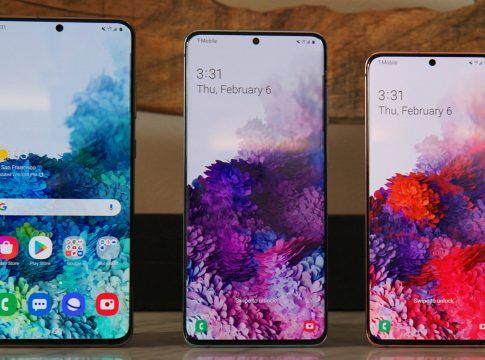Just as tradition, Samsung has announced its latest flagship phones: the Galaxy S20, Galaxy S20 Plus, and Galaxy S20 Ultra. All new phones will have the “5G” suffix to the names of those phones, as each one will support 5G in several selected markets. They’ll be available on March 6th with prices ranging from $999.99 (UGX 3.7m) to $1,599.99 (5.9m) before taxes, and preorders begin on February 21st.
The S20 lineup is the company’s statement for 2020 that it can still make the best Android phones. Though Samsung will tell you the name jumped from S10 to S20 because it represents a “new foundation,” what it really means is that Samsung is doing whatever it can to make you pay attention to these phones.
The 6.2-inch S20 has the lowest-end camera array of the three. The 6.7-inch S20 Plus adds better cameras. And finally, the S20 Ultra is unabashedly huge at 6.9 inches, with a camera system that’s as big and complex as nearly any other you can find on a phone.
The new design elements are minor: the hole punch for the selfie camera has been reduced and moved to the center, the camera bump has been extended into a rectangle to accommodate even more cameras, and the headphone jack is gone, making 2020 the first year when every major flagship phone from Samsung won’t have one.
The Galaxy S20 Display
If you are a Samsung user, it will come as no surprise that the Galaxy S20 phones look like: big screens, tiny bezels, and a metal rail sandwiched between two pieces of glass. The screens may be a little less aggressive at curving around the left and right of the phone, but if so, it’s a subtle difference. You can get them in a few colors, but unfortunately, the only one that’s available in “cloud pink” is the regular S20.
Each phone has an OLED HDR+ display that supports a 120Hz refresh rate. Interestingly, Samsung says it isn’t bothering trying to dynamically adjust that rate depending on what the screen is doing. It’s just a switch between 60Hz and 120Hz. The company claimed to me that setting it to the higher rate would only cause a 10 percent dip in battery life.

The Mega Cameras
Samsung is taking a big swing with the camera systems on these phones. Where Apple and Google have been talking up their computational photography chops, Samsung is doing what Samsung does best: throwing more hardware at the problem.
S20 Camera Specs
| Camera | S20 | S20 Plus | S20 Ultra |
|---|---|---|---|
| Ultra Wide | 12MP, 120˚, F2.2 | 12 MP, 120˚, F2.2 | 12 MP, 120˚, F2.2 |
| Wide | 12MP, 79˚, F1.8 | 12MP, 79˚, F1.8 | 108MP, 79˚, F1.8 |
| Telephoto | 64 MP, 76˚, F2.0 | 64MP, 76˚, F2.0 | 48MP, 24˚, F3.5 |
| Hybrid Optic Zoom | 3X | 3X | 10X |
| Super Res Zoom | 30X | 30X | 100X |
| Depth of Field | None | Yes | Yes |
| Selfie | 10MP, 80˚, F2.2 | 10MP, 80˚, F2.2 | 40MP, 80˚, F2.2 |
It seems Samsung is making a big bet on high megapixel counts. If you take a look at the S20 Plus and Ultra, you’ll see sensors of 48, 64, and 108 megapixels. All of these cameras will default to taking 12-megapixel photos by default, though you can go up to the full count if you like.
For the S20 Ultra, Samsung went all out and included a “folded” zoom lens, which means that the hole on the back of the phone actually hits a prism that redirects light across the phone to the sensor. It’s the same basic concept Huawei used in the P30 to achieve its zoom last year. That gets the S20 Ultra to 4x zoom. Then Samsung says it can do “lossless hybrid optic” zoom up to 10x though some combination of binning (combining multiple pixels into one big pixel) and sensor cropping. After that, it’s digital zoom up to 100x using similar methods.
Other Specs
In terms of specs, name one, and there’s a good chance the S20 phones will have it. They will all use the Qualcomm Snapdragon 865 processor, fast charging, wireless charging, Bluetooth 5.0, Wi-Fi 6, and so on. Each phone has 12GB of RAM paired to 128GB of storage by default (expandable via microSD). You can spend more to bring the Plus and Ultra up to 512GB of storage. When you do that on the Ultra, Samsung ups the RAM to 16GB.
The batteries are capacious — all the better to run those 120Hz screens. The S20 has a 4,000mAh battery, the Plus 4,500mAh, and the Ultra 5,000mAh. The Ultra feels thicker and heavier than the others as a result (and the periscope lens also probably adds some thickness).
Samsung called these the S20 because it wants them to be the start of a new generation of phones, but I don’t see a generational gap between the S10 and the S20.


